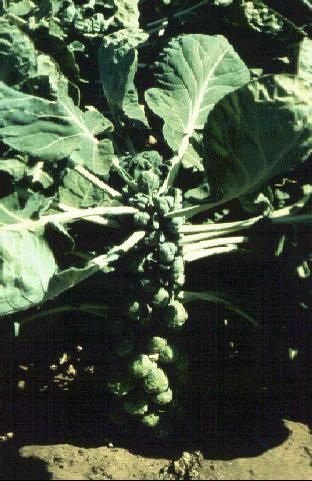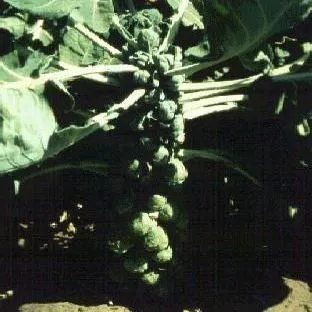Brussels Sprouts—Brassica oleracea L. (Gemmifera group)1
Brussels sprouts get their name from having been grown 400 years ago in the vicinity of Brussels, Belgium. As a commercial crop, it is produced in the United States, primarily in California and New York. Sprouts are a favorite crop in the British Isles, where they are widely grown. Very few sprouts are grown in Florida, and production is mostly in backyard gardens.
Description
Brussels sprouts are a tall-stemmed cabbage in which many tiny heads form at the bases of the leaves along the entire length of the central stalk. It is related to cabbage, kale, collards, cauliflower, kohlrabi, and broccoli. The round sprouts are about walnut size, from ¾ to 2 inches across, and are composed of tightly packed leaves. Each resembles a miniature cabbage head. The plants reach a height of 30 to 36 inches.

Credit: James M. Stephens
Culture
Brussels sprouts require cool weather for best growth. Warm weather causes individual sprouts to be soft and open rather than solid and tightly packed. An ideal average temperature is around 58–60°F. The plants withstand light to heavy frost; however, temperatures well below freezing are detrimental even to this hardy vegetable.
The best time to grow Brussels sprouts in Florida is during the winter. When planted in October through December, there is sufficient cool weather in most areas of the state for fair results. At other times of the year, such as the spring, temperatures become too high for quality sprout production.
Two varieties suggested for gardeners are 'Jade Cross,' a hybrid variety that matures in about 85 days, and 'Long Island Improved,' an open pollinated variety that takes a few days longer.
For those wishing to include a Brussels sprouts crop in their Florida gardens, it should be grown much like cabbage. Brussels sprouts can be started either from seeds or transplants.
The most common insect pests of Brussels sprouts in the Florida garden are loopers, imported cabbage worms, and aphids. Various diseases, such as downy mildew, can be damaging from time to time. Nematodes, if prevalent in the soil, will attack Brussels sprouts.
Harvesting and Storing
Sprouts are picked after they reach full size and become fairly firm but before they are tough and yellow. The first sprouts near the bottom of the plant are ready about 3 months after planting. Pull off the leaves below the mature sprouts, then remove the sprouts by twisting them from the stem. Pick the sprouts as needed, but usually at about 2-week intervals. Continue harvesting as long as good sprouts are formed.
Keep sprouts in the crisper of the refrigerator. Temperatures of 32–34°F and a relative humidity of 90–95% are best.



